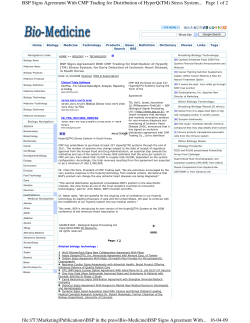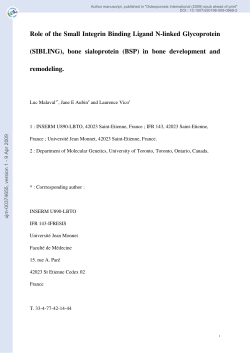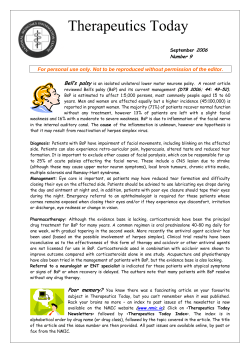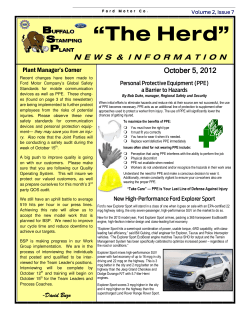
Bone Sialoprotein Is Predictive of Bone Metastases in
VOLUME 24 䡠 NUMBER 30 䡠 OCTOBER 20 2006 JOURNAL OF CLINICAL ONCOLOGY O R I G I N A L R E P O R T Bone Sialoprotein Is Predictive of Bone Metastases in Resectable Non–Small-Cell Lung Cancer: A Retrospective Case-Control Study Mauro Papotti, Thea Kalebic, Marco Volante, Luigi Chiusa, Elisa Bacillo, Susanna Cappia, Paolo Lausi, Silvia Novello, Piero Borasio, and Giorgio V. Scagliotti From the Department of Clinical & Biological Sciences, and Department of Biomedical Sciences & Oncology, University of Turin, San Luigi Hospital, Orbassano, Turin, Italy; and Novartis Oncology, East Hanover, NJ. Submitted February 24, 2006; accepted August 8, 2006. Supported by an unrestricted research grant from Novartis Pharma (New York, NY) Authors’ disclosures of potential conflicts of interest and author contributions are found at the end of this article. Address reprint requests to Giorgio V. Scagliotti, MD, PhD, Department of Clinical & Biological Sciences, University of Turin, San Luigi Hospital, Regione Gonzole 10, 10043 Orbassano, Torino, Italy; e-mail: giorgio.scagliotti@ unito.it. © 2006 by American Society of Clinical Oncology 0732-183X/06/2430-4818/$20.00 DOI: 10.1200/JCO.2006.06.1952 A B S T R A C T Purpose Bone metastases (BM) in non–small-cell lung cancer (NSCLC) may be detected at diagnosis or during the course of the disease, and are associated with a worse prognosis. Currently, there are no predictive or diagnostic markers to identify high-risk patients for metastatic bone dissemination. Patients and Methods Thirty patients with resected NSCLC who subsequently developed BM were matched for clinicopathologic parameters to 30 control patients with resected NSCLC without any metastases and 26 patients with resected NSCLC and non-BM lesions. Primary tumors were investigated by immunohistochemistry for 10 markers involved in bone resorption or development of metastases. Differences among groups were estimated by 2 test, whereas the prognostic impact of clinicopathologic parameters and marker expression was evaluated by univariate (Wilcoxon and Mantel-Cox tests) and multivariate (Cox proportional hazards regression model) analyses. Results The presence of bone sialoprotein (BSP) was strongly associated with bone dissemination (P ⬍ .001) and, independently, with worse outcome (P ⫽ .02, Mantel-Cox test), as defined by overall survival. To evaluate BSP protein expression in nonselected NSCLC, a series of 120 consecutive resected lung carcinomas was added to the study, and BSP prevalence reached 40%. No other markers showed a statistically significant difference among the three groups or demonstrated a prognostic impact, in terms of both overall survival and time interval to metastases. Conclusion BSP protein expression in the primary resected NSCLC is strongly associated with BM progression and could be useful in identifying high-risk patients who could benefit from novel modalities of surveillance and preventive treatment. J Clin Oncol 24:4818-4824. © 2006 by American Society of Clinical Oncology INTRODUCTION Non–small-cell lung cancer (NSCLC) is the leading cause of cancer-related deaths worldwide, mostly secondary to diffuse extrathoracic dissemination of the neoplastic disease to several organs and systems, including bone. Metastatic lesions in the bone may be present at diagnosis or develop during the course of tumor progression. A growing body of data suggests that metastatic dissemination is site specific and that distinct molecular pathways regulate formation of bone metastases (BM), but diagnostic modalities to predict which individual patients will develop BM remain limited.1,2 The identification of NSCLC subgroups with an increased risk of developing BM is critical for indi- vidualized clinical management and improved accuracy of tumor diagnosis. A multifactorial and multistep process of BM formation involves several biologic mechanisms including angiogenesis, invasion of extracellular matrix, osteoclast activation, and bone remodeling. A number of molecular factors involved in metastatic dissemination are associated with survival of lung cancer patients. Those include, angiogenetic factors, extracellular matrix degrading proteins such as metalloproteinases and their inhibitors (matrix metalloproteinases [MMPs] and tissue inhibitor of metalloproteinases [TIMPs]), and proteins implicated in bone resorption, including cathepsin K, tartrate-resistant acid phosphatase (TRAcP), or bone sialoprotein (BSP).3-11 Increased serum 4818 Downloaded from jco.ascopubs.org on June 9, 2014. For personal use only. No other uses without permission. Copyright © 2006 American Society of Clinical Oncology. All rights reserved. Bone Sialoprotein in Lung Carcinoma levels of periostin were found to be associated with BM in breast cancer but not in lung cancer.9 BSP was shown to be highly expressed in different histologic types of lung cancers by both protein and mRNA analysis,12 as opposed to nonosteotropic cancers (eg, ovarian cancer). Molecular factors investigated in our study have been shown previously to play a role in tumor invasion and metastasis formation, but the association of any of those molecules with BM progression of NSCLC has not been established. We investigated whether a subpopulation of primary NSCLC with a propensity to form BM shows a distinct expression pattern of markers when compared with NSCLCs that do not metastasize to bone. In a nested case-control study of completely resected NSCLC, including stage IA to IIIB tumors, we conducted a retrospective analysis to determine the predictive and prognostic value of a panel of markers by correlating the level of marker expression in primary tumors with BM progression status and survival rate. PATIENTS AND METHODS Tumor Sample Selection From the surgical database of the Division of Thoracic Surgery, San Luigi Hospital, University of Turin (Turin, Italy), which includes surgically resected NSCLC patients from April 1993 to August 2003 with follow-up, 30 patients with NSCLC who developed BM after surgery (group A [BMET positive]) were extracted. This group comprised the total number of NSCLCs with BM progression deposited in the database for which clinical information was available. Two control groups were selected from the same database in the same time period, and included 30 patients without any metastatic progression during the follow-up (with local recurrence only in patients who died as a result of the disease; group B [MET negative]), and 26 patients who developed metastases other than to the bone during the follow-up (group C [MET positive]). The two control groups were matched with the patients in group A (BMET positive), which suggests identical or similar sex, age, histologic diagnosis, grade, pTN stage, and adjuvant therapy administered. Two pathologists (M.P. and M.V.) confirmed the histologic type, tumor grade, and stage. The main clinicopathologic features of the three groups are reported in Table 1. The mean follow-up time was comparable in the two groups with metastatic progression; namely, 27.2 and 21.1 months in group A (BMET positive) and group C (MET positive), respectively. A large series of 120 consecutive patients with completely resected NSCLC, observed between November 2003 and September 2004 at the same institution (group D; male-to-female ratio, 3:1; mean age, 67 years; histologic subtype: adenocarcinoma, 55%, squamous cell carcinoma, 39%; other, 6%; stages: I, 54%; II, 17%; III, 29%) was analyzed and BSP protein was evaluated by immunohistochemistry. The study was approved by the Institutional Review Board of the hospital. All samples were made anonymous and none of the researchers conducting the experiments in the study had access to clinicopathologic data. Methods Serial 5-m-thick paraffin sections were collected onto charged slides and processed by immunohistochemistry with the following primary antibodies recognizing a set of markers involved mostly in bone resorption or metastatic process: cathepsin K (Novocastra, Newcastle, United Kingdom); BSP (Chemicon, Temecula, CA); vascular endothelial growth factor, MMP-2, and p53 (NeoMarkers/LabVision, Fremont, CA); reversion-inducing cysteinerich protein with kazal motifs (RECK; BD Biosciences, San Jose, CA), TIMP-1 (LabVision, Fremont, CA); CD-117 (c-Kit) and Ki-67 (DakoCytomation, Glostrup, Denmark); and TRAcP (Zymed, San Francisco, CA). A standard automated immunoperoxidase procedure (Autostainer; Dako, Glostrup, Denmark) was used, and the appropriate working conditions were set in the laboratory by testing appropriate internal and external controls in parallel. Detailed working conditions for all antibodies used in the study are available from the authors. Immunoreactions were revealed by a secondary antibody and a biotin-free dextran-chain detection system (Envision, Dako), and developed using diaminobenzidine as the chromogen. For MMP-2, cathepsin K, TIMP-1, CD117, p53, vascular endothelial growth factor, BSP, RECK, and TRAcP, the intensity of the immune reaction was assessed by a semiquantitative score according to the percentage of positive tumor cells (from score 1 to 4: 0, ⬍ 10%, 10% to 50%, and ⬎ 50%, respectively). For the purpose of statistical analysis, tumors were coded as negative (score 1) or positive (scores 2, 3, and 4). The immunoreaction was considered specific in the presence of an intense brown chromogen deposition, without any background. Ki-67 was evaluated as percentage of Table 1. Clinicopathologic Data of 30 Resected NSCLC Patients Who Developed Bone Metastases and of the Corresponding Matched Controls Groupⴱ No. Male No. Female Mean Age (years) A (n ⫽ 30) 21 9 62.2 B (n ⫽ 30) 21 9 63.1 C (n ⫽ 26) 19 7 60.9 Time to Metastases (months) Diagnosis Grade pT pN ADC (n ⫽ 21) SQC (n ⫽ 6) ULCC (n ⫽ 2) AD/SQC (n ⫽ 1) BAC (n ⫽ 0) ADC (n ⫽ 18) SQC (n ⫽ 7) ULCC (n ⫽ 1) AD/SQC (n ⫽ 1) BAC (n ⫽ 3) ADC (n ⫽ 16) SQC (n ⫽ 7) ULCC (n ⫽ 2) AD/SQC (n ⫽ 1) BAC (n ⫽ 0) 1 (n ⫽ 3) 2 (n ⫽ 16) 3 (n ⫽ 11) pT1-2 (n ⫽ 19) pT3-4 (n ⫽ 11) pNx (n ⫽ 2) pN0 (n ⫽ 10) pN1-2 (n ⫽ 18) 1 (n ⫽ 3) 2 (n ⫽ 16) 3 (n ⫽ 11) pT1-2 (n ⫽ 20) pT3-4 (n ⫽ 10) pNx (n ⫽ 0) pN0 (n ⫽ 12) pN1-2 (n ⫽ 18) 1 (n ⫽ 1) 2 (n ⫽ 12) 3 (n ⫽ 13) pT1-2 (n ⫽ 18) pT3-4 (n ⫽ 8) pNx (n ⫽ 1) pN0 (n ⫽ 8) pN1-2 (n ⫽ 17) Time to FollowUp (months) Median Range Adjuvant Therapy† Median Range Bone (n ⫽ 30) Liver (n ⫽ 2) Lung (n ⫽ 7) CNS (n ⫽ 3) Other (n ⫽ 2) — 7.5 0.7-78.2 15 (4 NA) 17.4 6-88 15 (1 NA) 77.1 0.2-179 Liver (n ⫽ 2) Lung (n ⫽ 15) CNS (n ⫽ 7) Adrenal (n ⫽ 4) 6.9 12 (3 NA) 17.7 3-51 Metastatic Site — 0.1-29.9 Abbreviations: NSCLC, non–small-cell lung cancer; NA, neoadjuvant; ADC, adenocarcinoma; SQC, squamous cell carcinoma; ULCC, undifferentiated large cell carcinoma; AD/SQC, adeno-squamous carcinoma; BAC, bronchioloalveolar carcinoma. ⴱ Group A, NSCLC with bone metastases; group B, nonmetastatic NSCLC; group C, NSCLC with metastases other than to the bone. †Radiotherapy or chemotherapy or in combination. 4819 www.jco.org Downloaded from jco.ascopubs.org on June 9, 2014. For personal use only. No other uses without permission. Copyright © 2006 American Society of Clinical Oncology. All rights reserved. Papotti et al positive nuclei after counting 1,000 cells in areas of the highest labeling density. For statistical analysis, Ki-67 levels were grouped in the same scoring system as for the other markers; in addition, a cutoff of 48%, representing the mean value, was also considered. Statistical Analysis All data were analyzed with BMDP statistical software (University of California Press, Berkeley, CA). A level of P ⬍ .05 was considered statistically significant. The differential expression of the markers in the three groups was estimated by Pearson’s 2 test (or analysis of variance in the case of Ki-67). Univariate survival analysis was based on the Kaplan-Meier product limit estimate of overall survival distribution. Differences between survival curves were tested using the Wilcoxon and Mantel-Cox tests. The relative importance on survival of each parameter included in the univariate analysis was estimated using the Cox proportional hazards regression model. RESULTS A four-grade score, as described in Patients and Methods, was segregated into different populations to conduct statistical analysis to assess survival and to determine differential expression of markers, when compared the metastatic groups A (BMET positive) and C (MET positive) and nonmetastatic group B (MET negative). Among multiple markers investigated in this study, we have identified that the presence of BSP expression strongly correlates (P ⬍ .001) with the development of BM (Table 2). BSP protein (which in normal lung tissue was detected only in the apical portion of bronchial cells) was expressed in 80% of tumors in group A (BMET positive; Fig 1), compared with 20% and 31%, respectively, in groups B (MET negative) and C (MET positive). This observation was maintained also when early-stage tumors were considered alone (stages I and II; a total number of 34 patients), with a percentage of 75% in group A (BMET positive), nearly 17% in group B (MET negative), and 40% in C (MET positive; 2 ⫽ 8,379; P ⫽ .01). On the basis of these findings, we investigated also the prevalence of BSP protein expression in nonselected NSCLC. In this group, BSP positivity (score ⱖ 1) reached 40%, without any significant difference according to histologic subtype or other clinicopathologic parameters. The strong association between BSP expression and development of BM was maintained also when the different cutoff values of the semiquantitative score were used. However, a statistically significant difference was observed in the distribution of the score values in groups A, B, and C, as well as in the series of 120 consecutive NSCLC Table 2. Immunohistochemical Marker Expression in Metastatic and Nonmetastatic NSCLC Groupⴱ Marker Status† Cathepsin K Negative Positive MMP-2 Negative Positive TIMP-1 Positive ⱕ 50% Positive ⬎ 50% p53 Negative Positive CD117 Negative Positive VEGF Positive ⬍ 10% Positive 10-50% Positive ⬎ 50% BSP Negative Positive RECK Negative Positive TRAcP Negative Positive Ki-67 Mean percentage A B C n ⫽ 30 15 15 n ⫽ 29 20 9 n ⫽ 30 4 26 n ⫽ 30 16 14 n ⫽ 30 23 7 n ⫽ 30 2 12 16 n ⫽ 30 6 24 n ⫽ 29 4 25 n ⫽ 30 18 12 n ⫽ 20 39.4 n ⫽ 30 15 15 n ⫽ 30 17 13 n ⫽ 30 5 25 n ⫽ 30 14 16 n ⫽ 30 19 11 n ⫽ 30 3 7 20 n ⫽ 30 24 6 n ⫽ 30 9 21 n ⫽ 30 23 7 n ⫽ 27 49.7 n ⫽ 26 14 12 n ⫽ 26 16 10 n ⫽ 25 7 18 n ⫽ 26 14 12 n ⫽ 26 20 6 n ⫽ 25 0 10 15 n ⫽ 26 18 8 n ⫽ 26 10 16 n ⫽ 26 20 6 n ⫽ 18 43.2 Statistical Parameters Pearson’s 2 ⫽ 0.1; df ⫽ 2 P ⫽ .9 Pearson’s 2 ⫽ 0.9; df ⫽ 2 P ⫽ .6 Pearson’s 2 ⫽ 2.1; df ⫽ 2 P ⫽ .3 Pearson’s 2 ⫽ 0.4; df ⫽ 2 P ⫽ .8 Pearson’s 2 ⫽ 1.7; df ⫽ 2 P ⫽ .4 Pearson’s 2 ⫽ 4.4; df ⫽ 2 P ⫽ .3 Pearson’s 2 ⫽ 24.6; df ⫽ 2 P ⬍ .001 Pearson’s 2 ⫽ 4.4; df ⫽ 2 P ⫽ .1 Pearson’s 2 ⫽ 2.6; df ⫽ 2 P ⫽ .2 One-way ANOVA P ⫽ .3 Abbreviations: MMP-2, matrix metalloproteinase-2; TIMP-1, tissue inhibitor of metalloproteinase-1; VEGF, vascular endothelial growth factor; BSP, bone sialoprotein; RECK, reversion-inducing cysteine-rich protein with kazak motifs; TRAcP, tartrate-resistant acid phosphatase. ⴱ Group A, NSCLC with bone metastases; group B, nonmetastatic NSCLC; group C, NSCLC with metastases other than to the bone. †Negative, score 1; positive, positive, irrespective of the percentage of immunostained tumor cells (including scores 2, 3, and 4; see Patients and Methods). 4820 JOURNAL OF CLINICAL ONCOLOGY Downloaded from jco.ascopubs.org on June 9, 2014. For personal use only. No other uses without permission. Copyright © 2006 American Society of Clinical Oncology. All rights reserved. Bone Sialoprotein in Lung Carcinoma Fig 1. Bone sialoprotein (BSP) expression in non–small-cell lung cancer. (A) Strong BSP immunostaining in group A with metastatic to bone tumors ([BMET] positive). (B) In group C (MET positive), BSP immunoreactivity was present in a minority of cases, whereas (C) it was absent in the majority of nonmetastatic patients, group B (MET negative; apical staining in normal bronchial cells). (group D): score 3 was most prevalent in the group A (BMET positive) compared with the other groups (2 test, P ⬍ .01). No other marker, either considered alone or in combination, was able to distinguish the three groups of primary NSCLC. We have also analyzed the different histologic subtypes, and observed (irrespective of the group in which they were included) statistically significant differences in marker expression among adenocarcinomas and squamous cell carcinomas. The latter group showed a higher proliferative index (58% compared with 33%; P ⬍ .001), and a higher percentage of positive nuclei in the p53-reactive cases (57% compared with 23%; P ⬍ .001). In contrast, adenocarcinomas expressed higher levels of CD117 (34% compared with 10% in squamous cell carcinomas; P ⫽ .03). Comparable levels of BSP expression have been shown in both squamous cell carcinomas and adenocarcinomas. The analysis of overall survival showed a significant difference (P ⬍ .001) in the three groups: the 5-year survival rate was 19% in group A (BMET positive), 0% in group C (MET positive), and 80% in group B (MET negative; Table 3; Fig 2A). When all the three groups were analyzed together, or the metastatic groups A (BMET positive) and C (MET positive) were considered alone, BSP expression was found to be significantly correlated to poor prognosis (P ⫽ .02; Fig 2B). We have confirmed that BSP protein expression is an independent prognostic factor by multivariate analysis using the Cox proportional hazards regression model (2 ⫽ 5.56; P ⫽ .01). Our study also showed that none of the investigated markers correlated with the time to metastatic progression. DISCUSSION In this study, we evaluated a broad panel of markers reported to be involved in the regulation of metastatic dissemination and found to be associated with metastatic tumors. Our goal was to determine whether any of those markers, or a combination of markers, could distinguish the primary NSCLC tumors that progress to BM from those tumors that do not. We have identified BSP expression to be significantly increased in a series of primary NSCLC metastasizing to bone, when compared with matched control groups of NSCLC (metastatic or nonmetastatic) that did not progress to bone in a comparable period of time. BSP protein expression was also found to be predictive of poor prognosis, but not related to the time interval to metastatic progression. Moreover, in a large consecutive series of resected NSCLC, we observed a prevalence of BSP protein expression of 40%; the percentage of positivity is intermediate between that in group A (BMET positive) and in groups B (MET negative) and C (MET positive). Our data are in agreement with previous findings on BSP protein expression in a variety of malignant tumors including thyroid,13 breast,14-16 prostate,17 and lung12 cancers. Indeed, a prognostic role of BSP expression has been reported.15,17 In addition, elevated serum BSP levels have been detected in patients affected by different types of solid tumors.8 An increased expression of BSP has been found in BM, when compared with visceral metastases in breast and prostate carcinomas.16 Although there is growing evidence of an association between BSP and tumor progression, a potential role of BSP in regulating BM is poorly understood. Increased expression of BSP in transfected tumor cells has been shown to confer increased invasive capacity.17 BSP protein has been shown to promote tumor cell growth, attachment, and migratory response in breast cancer cell lines, via interaction with ␣V3 and ␣V5 integrins by means of a specific integrin-binding RGD (Arg-Gly-Asp) domain.18,19 In in vitro models, a linkage of BSP to ␣V3 integrin and MMP-2 had been demonstrated recently, and interference with the BSP–MMP-2 complex by specific chemical inhibitors or monoclonal antibodies against MMP-2 was able to block BSP-enhanced invasiveness, which suggest a potential role of BSP in cancer cell invasiveness.20 BSP biding sites have also been identified in collagen type I, a major structural component of bone matrix21 (Fig 3). NSCLC patients expressing BSP and potentially at high risk of bone dissemination may be reasonably good candidates for preventive treatments with bone metabolic agents to offset the osteotropic behavior of their cancer.22 Randomized controlled trials recently assessed the potential role of bisphosphonates in the prevention of BM in prostate cancer.23,24 One such agent (zoledronic acid) has been demonstrated to increase BSP production by osteoblastic cells,25 thus suggesting that possible interaction between the two molecules might be effective. Additional studies are needed both to clarify 4821 www.jco.org Downloaded from jco.ascopubs.org on June 9, 2014. For personal use only. No other uses without permission. Copyright © 2006 American Society of Clinical Oncology. All rights reserved. Papotti et al Table 3. Univariate Statistical Analysis for Overall Survival Survival Time (months) Statusⴱ Group A B C Sex Female Male Age, years ⱕ 60 ⬎ 60 Tumor type ADC SQC ULCC AD/SQC BAC Grade 1 2 3 pT stage 1-2 3-4 pN stage† 0 1-2 AJCC stage† I-II III-IV ki-67, % ⱕ 48 ⬎ 48 MMP-2 Negative Positive Cathepsin K Negative Positive TIMP-1, % ⱕ 50 ⬎ 50 p53 Negative Positive CD117 Negative Positive VEGF, % ⬍ 10 10-50 ⬎ 50 BSP Negative Positive RECK Negative Positive TRAcP Negative Positive No. of Patients Median 30 30 26 Survival Rate (%) 95% CI 1 Years 3 Years 5 Years 17 Not reached 17 1 to 84 1 to 95 77 96 80 24 89 25 19 80 0 ⬍ .001 25 61 31 28 2 to 23 1 to 27 91 82 50 46 43 32 .5 30 56 36 27 1 to 77 1 to 52 79 87 52 44 31 37 .8 55 20 5 3 3 35 29 8 — — 1 to 39 2 to 25 4 to 9 89 95 0 33 100 50 42 0 33 100 32 42 0 33 100 11 38 37 76 25 25 3 to 44 1 to 72 1 to 73 91 92 75 82 37 55 60 29 32 .2 56 30 36 20 1 to 39 1 to 85 87 79 50 39 37 31 .5 30 53 36 20 1 to 90 1 to 38 90 82 50 42 39 32 .2 33 49 36 22 1 to 81 1 to 64 84 85 52 43 37 32 .4 34 31 31 39 1 to 72 1 to 87 88 83 47 59 36 42 .7 53 32 25 39 1 to 38 1 to 86 81 90 44 54 31 43 .1 44 42 31 28 1 to 53 1 to 59 86 82 47 47 34 36 .7 17 68 25 31 1 to 81 1 to 41 87 84 44 47 36 35 .7 44 42 26 31 1 to 51 1 to 62 81 87 47 46 34 36 .8 62 24 28 39 1 to 29 2 to 13 86 79 44 56 34 38 .5 5 29 51 — 25 31 1 to 87 1 to 41 100 79 86 67 42 48 67 36 33 .4 48 38 39 25 1 to 46 1 to 68 85 83 57 34 44 23 .02 23 62 36 27 1 to 54 1 to 84 83 86 50 45 32 37 .9 61 25 26 36 1 to 75 1 to 81 85 83 45 50 36 35 .9 Mantel-Cox P .5 .09 (1 v 2/3) Abbreviations: ADC, adenocarcinoma; SQC, squamous cell carcinoma; ULCC, undifferentiated large cell carcinoma; AD/SQC, adeno-squamous carcinoma; BAC, bronchioloalveolar carcinoma; AJCC, American Joint Committee on Cancer; MMP-2, matrix metalloproteinase-2; TIMP-1, tissue inhibitor of metalloproteinase-1; VEGF, vascular endothelial growth factor; BSP, bone sialoprotein; RECK, reversion-inducing cysteine-rich protein with kazak motifs; TRAcP, tartrate-resistant acid phosphatase. ⴱ Negative, score 1; positive, scores 2, 3 and 4, which are considered irrespective of the percentage of immunostained tumor cells. †Three patients were staged pNx. 4822 JOURNAL OF CLINICAL ONCOLOGY Downloaded from jco.ascopubs.org on June 9, 2014. For personal use only. No other uses without permission. Copyright © 2006 American Society of Clinical Oncology. All rights reserved. Bone Sialoprotein in Lung Carcinoma Fig 3. Hypothetical role of bone sialoprotein (BSP) protein expression by non–small-cell lung cancer (NSCLC) cells in bone dissemination, via increased invasive capacity and adhesion to bone extracellular matrix by interacting with ␣V3 integrin; in addition, BSP biding sites have also been identified in collagen type I, a major structural component of bone matrix (see text for references). VCAM-1, vascular cell adhesion molecule-1; TGF, transforming growth factor beta; Rank, receptor activator of nuclear factor– kappa B. Fig 2. (A) Overall survival distribution of non–small-cell lung cancer (NSCLC), grouped according to tumor progression as bone metastatic (group A), nonmetastatic (group B), and metastatic positive (group C). (B) Overall survival distribution of NSCLC grouped according to bone sialoprotein (BSP) protein expression. mechanistically a possible interplay of bisphosphonates in regulating normal and neoplastic BSP secretion and to set their possible clinical use to prevent BM in lung cancer. With the exception of BSP, the other molecules evaluated in our study did not show any correlation with BM development. Some of these markers, however, seemed to correlate with a specific tumor histologic subtype but failed to correlate with metastatic spread or survival. REFERENCES 1. Roodman GD: Mechanisms of bone metastasis. N Engl J Med 350:1655-1664, 2004 2. Horak CE, Steeg PS: Metastasis gets site specific. Cancer Cell 8:93-95, 2005 3. Cho NH, Hong KP, Hong SH, et al: MMP expression profiling in recurred stage IB lung cancer. Oncogene 23:845-851, 2004 4. Karameris A, Panagou P, Tsilalis T, et al: Association of expression of metalloproteinases and their inhibitors with the metastatic potential of squamous-cell lung carcinomas: A molecular and immunohistochemical study. Am J Respir Crit Care Med 156:1930-1936, 1997 5. Kumaki F, Matsui K, Kawai T, et al: Expression of matrix metalloproteinases in invasive pulmonary adenocarcinoma with bronchioloalveolar component and atypical adenomatous hyperplasia. Am J Pathol 59:2125-2135, 2001 In summary, we found BSP expression to be strongly correlated with a subgroup of primary NSCLC tumors that have a propensity to form BM, as opposed to a subgroup of NSCLC tumors devoid of such propensity. These data strongly suggest that increased BSP expression can be used as a predictive marker of BM risk at the time of surgery for NSCLC. Moreover, our study confirms that BSP expression is an independent adverse prognostic factor. Therefore, BSP evaluation in primary NSCLC may offer a powerful tool to predict a risk of bonespecific metastatic progression in individual patients. Novel modalities for treatment of NSCLC are under intense investigation, but improved diagnostic approaches for early tumor detection or prediction of site-specific metastatic lesions are critical for more effective individualized therapy.26 Our study suggests that the NSCLC patients with increased BSP expression may benefit from an individualized surveillance regimen and preventive therapeutic intervention designed to block or delay the development of BM. 6. Reichenberger F, Eickelberg O, Wyser C, et al: Distinct endobronchial expression of matrixmetalloproteinases (MMP) and their endogenous inhibitors in lung cancer. Swiss Med Wkly 131:273279, 2001 7. Takenaka K, Ishikawa S, Kawano Y, et al: Expression of a novel matrix metalloproteinase regulator, RECK, and its clinical significance in resected non-small cell lung cancer. Eur J Cancer 40:16171623, 2004 8. Fedarko NS, Jain A, Karadag A, et al: Elevated serum bone sialoprotein and osteopontin in colon, breast, prostate, and lung cancer. Clin Cancer Res 7:4060-4066, 2001 9. Sasaki H, Yu CY, Dai M, et al: Elevated serum periostin levels in patients with bone metastases from breast but not lung cancer. Breast Cancer Res Treat 77:245-252, 2003 10. Littlewood-Evans AJ, Bilbe G, Bowler WB, et al: The osteoclast-associated protease cathepsin K is expressed in human breast carcinoma. Cancer Res 57:5386-5390, 1997 11. Brubaker KD, Vessella RL, True LD, et al: Cathepsin K mRNA and protein expression in prostate cancer progression. J Bone Miner Res 18:222-230, 2003 12. Bellahcene A, Maloujahmoum N, Fisher LW, et al: Expression of bone sialoprotein in human lung cancer. Calcif Tissue Int 61:183-188, 1997 13. Bellahcene A, Albert V, Pollina L, et al: Ectopic expression of bone sialoprotein in human thyroid cancer. Thyroid 8:637-641, 1998 14. Bellahcene A, Merville MP, Castronovo V: Expression of bone sialoprotein, a bone matrix protein, in human breast cancer. Cancer Res 54:2823-2826, 1994 15. Bellahcene A, Menard S, Bufalino R, et al: Expression of bone sialoprotein in primary human breast cancer is associated with poor survival. Int J Cancer 69:350-353, 1996 16. Waltregny D, Bellahcene A, de Leval X, et al: Increased expression of bone sialoprotein in bone metastases compared with visceral metastases in 4823 www.jco.org Downloaded from jco.ascopubs.org on June 9, 2014. For personal use only. No other uses without permission. Copyright © 2006 American Society of Clinical Oncology. All rights reserved. Papotti et al human breast and prostate cancers. J Bone Miner Res 15:834-843, 2000 17. Waltregny D, Bellahcene A, Van Riet I, et al: Prognostic value of bone sialoprotein expression in clinically localized human prostate cancer. J Natl Cancer Inst 90:1000-1008, 1998 18. Sung V, Stubbs JT III, Fisher L, et al: Bone sialoprotein supports breast cancer cell adhesion proliferation and migration through differential usage of the alpha(v)beta3 and alpha(v)beta5 integrins. J Cell Physiol 176:482-494, 1998 19. Yoneda T, Hiraga T: Crosstalk between cancer cells and bone microenvironment in bone metastasis. Biochem Biophys Res Commun 328:679-687, 2005 20. Karadag A, Ogbureke KU, Fedarko NS, et al: Bone sialoprotein, matrix metalloproteinase 2, and alpha(v)beta3 integrin in osteotropic cancer cell invasion. J Natl Cancer Inst 96:956-965, 2004 21. Tye CE, Hunter GK, Goldberg HA: Identification of the type I collagen-binding domain of bone sialoprotein and characterization of the mechanism of interaction. J Biol Chem 280:13487-13492, 2005 22. Hirsh V, Tchekmedyian NS, Rosen LS, et al: Clinical benefit of zoledronic acid in patients with lung cancer and other solid tumors: Analysis based on history of skeletal complications. Clin Lung Cancer 6:170-174, 2004 23. Smith MR, Kabbinavar F, Saad F, et al: Natural history of rising serum prostate-specific antigen in men with castrate nonmetastatic prostate cancer. J Clin Oncol 23:2918-2925, 2005 24. Michaelson MD, Smith MR: Bisphosphonates for treatment and prevention of bone metastases. J Clin Oncol 23:8219-8224, 2005 25. Chaplet M, Detry C, Deroanne C, et al: Zoledronic acid up-regulates bone sialoprotein expression in osteoblastic cells through Rho GTPase inhibition. Biochem J 384:591-598, 2004 26. Szabo E, Kalebic T: Chemoprevention of lung cancer: New directions. Recent Results Cancer Res 163:172-181, 2003 ■ ■ ■ Acknowledgment We thank I. Rapa, PhD, and R. Rosas, PhD, (University of Turin) for their skillful technical assistance. Appendix The Appendix is included in the full-text version of this article, available online at www.jco.org. It is not included in the PDF version (via Adobe® Reader®). Authors’ Disclosures of Potential Conflicts of Interest Although all authors completed the disclosure declaration, the following authors or their immediate family members indicated a financial interest. No conflict exists for drugs or devices used in a study if they are not being evaluated as part of the investigation. For a detailed description of the disclosure categories, or for more information about ASCO’s conflict of interest policy, please refer to the Author Disclosure Declaration and the Disclosures of Potential Conflicts of Interest section in Information for Contributors. Authors Thea Kalebic Employment Leadership Consultant Novartis Pharma (N/R) Stock Honoraria Research Funds Testimony Other Novartis Pharma (B) Dollar Amount Codes (A) ⬍ $10,000 (B) $10,000-99,999 (C) ⱖ $100,000 (N/R) Not Required Author Contributions Conception and design: Mauro Papotti, Thea Kalebic, Giorgio V. Scagliotti Financial support: Mauro Papotti, Thea Kalebic, Giorgio V. Scagliotti Administrative support: Giorgio V. Scagliotti Provision of study materials or patients: Mauro Papotti, Marco Volante, Elisa Bacillo, Susanna Cappia, Paolo Lausi, Silvia Novello, Piero Borasio, Giorgio V. Scagliotti Collection and assembly of data: Marco Volante, Elisa Bacillo Data analysis and interpretation: Marco Volante, Luigi Chiusa Manuscript writing: Mauro Papotti, Marco Volante, Giorgio V. Scagliotti Final approval of manuscript: Mauro Papotti, Thea Kalebic, Marco Volante, Luigi Chiusa, Elisa Bacillo, Susanna Cappia, Paolo Lausi, Silvia Novello, Piero Borasio, Giorgio V. Scagliotti 4824 JOURNAL OF CLINICAL ONCOLOGY Downloaded from jco.ascopubs.org on June 9, 2014. For personal use only. No other uses without permission. Copyright © 2006 American Society of Clinical Oncology. All rights reserved.
© Copyright 2025





















